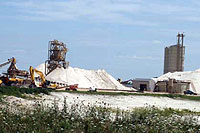Industrial Sand Mining Strategic Analysis
The Department of Natural Resources has prepared a strategic analysis to reassess the latest scientific, natural resource and socioeconomic information relating to industrial sand mining and its associated infrastructure in Wisconsin.
The strategic analysis updates information provided in a 2012 DNR document entitled, Silica Sand Mining in Wisconsin.
Public review
Public comments on the strategic analysis were received by the department from July 5 to August 22, 2016. The department also held a hearing on July 26, 2016. Sixty people attended the hearing and 22 individuals spoke on the record. The department also received 50 comments by email and letter. Thanks to all who reviewed the strategic analysis, all who attended the hearing and all who provided comments. Audio transcripts of the hearing and written comments received are available at the links below.
- Hearing transcript 1 [MP3]
- Hearing transcript 2 [MP3]
- Comments (redacted to protect the contact information of private individuals)
The department considered all public comments in the final analysis. The department's comment response document highlights revisions in the analysis.
Strategic analysis process
A strategic analysis evaluates factual information to inform policies and approaches for contentious resource issues. This process is outlined in Chapter NR 150, Wis. Adm. Code.
The purpose of the analysis is to inform future discussions and decisions.
Strategic analysis follows these general steps.
- Scoping - defining the topics and information sources to be considered and the analytical methods to be employed. This step includes public input.
- Information gathering and analysis.
- Document preparation.
- Public review - at least 45 days will be allotted for public review of the analysis and a hearing may be held.
- Comment response - the department will consider all comments received and may revise the analysis if warranted.
- The final version of the analysis document and all comments and supporting information will be made publicly available. < we are here
Groundwater study
In addition to this strategic analysis, the Department is collaborating with a variety of stakeholders in developing a study to evaluate process-water ponds and how they function at industrial sand sites. Process-water is stored in ponds to wash and sort the aggregate material and is then returned to the ponds. This study includes two phases to, 1) characterize the variety of industrial sand mines, their local site geology, water resources and processing operations, and 2) evaluate the water chemistry of the process water including metals. The study design will incorporate quality control/assurance parameters, data collection and management procedures, reporting strategies, and methods for disseminating information. It is important to note that this study is NOT a comprehensive study of all aspects of the potential influence of the industrial sand industry on groundwater.
Projected timeline
- Draft the scope of work (SOW) and study sideboards – May 2017
- Engage stakeholders to finalize SOW, draft a request for proposals (RFP) and form a technical team for study oversight – June 2017
- Select contractor and launch study – Fall 2017
Stakeholders
Stakeholders may provide technical support, guidance, information, public outreach or funding.
Possible partners include but are not limited to:
- Wisconsin Geologic and Natural History Survey
- Wisconsin Industrial Sand Association (WISA)
- Wisconsin Manufacturers and Commerce
- The Nature Conservancy
- United States Geologic Service (USGS)
- University of Wisconsin – Eau Claire and Stevens Point
- Wisconsin Department of Natural Resources (DNR)
Industrial sand mining
Silica sand or silicon dioxide (SiO2), also referred to as quartz, has been mined for thousands of years and has many uses, from paving roads to filtering drinking water. Sand used in the petroleum industry has been produced in Wisconsin for over 40 years. In recent years, however, the demand for industrial sand has increased exponentially. This growth in industrial sand mining can be attributed to the oil and gas extraction technique known as hydraulic fracturing which relies on silica sand.
While there is no hydraulic fracturing occurring in Wisconsin, the state has areas which contain high-quality silica sands which are mined for use in hydraulic fracturing outside of the state.
More information and locations of sand mines in Wisconsin
For maps and other information on industrial sand mining operations and regulations go to Industrial sand mining.
Public scoping
In 2014 the DNR invited the public to participate in helping us to determine the scope of the analysis. We provided an online input form and accepted emails and letters. This public review period ended on April 20, 2014. The DNR received over 800 responses from the public via letters, emails and the online form. We have reviewed this information and incorporated the public input into the strategic analysis.
Here’s a brief summary of the feedback the DNR received from the public during the public scoping review period. We received 860 online forms of which 340 included general concerns about industrial sand mining and 384 provided more specific concerns in the topics we provided. The other 136 forms did not provide comments but included names and/or email addresses. We also received 41 emails and 16 written responses. Midwest Environmental Associates held three public meetings and submitted written comments from those meetings to the DNR. We also received data and reports about the industry from several other sources. All the scoping input received by the DNR is available at the links below.
- Contact information
- For more information about this strategic analysis, please contact:
- Roberta Walls
Environmental Assistance Coordinator
Environmental Analysis and Sustainability program
608-785-9272


